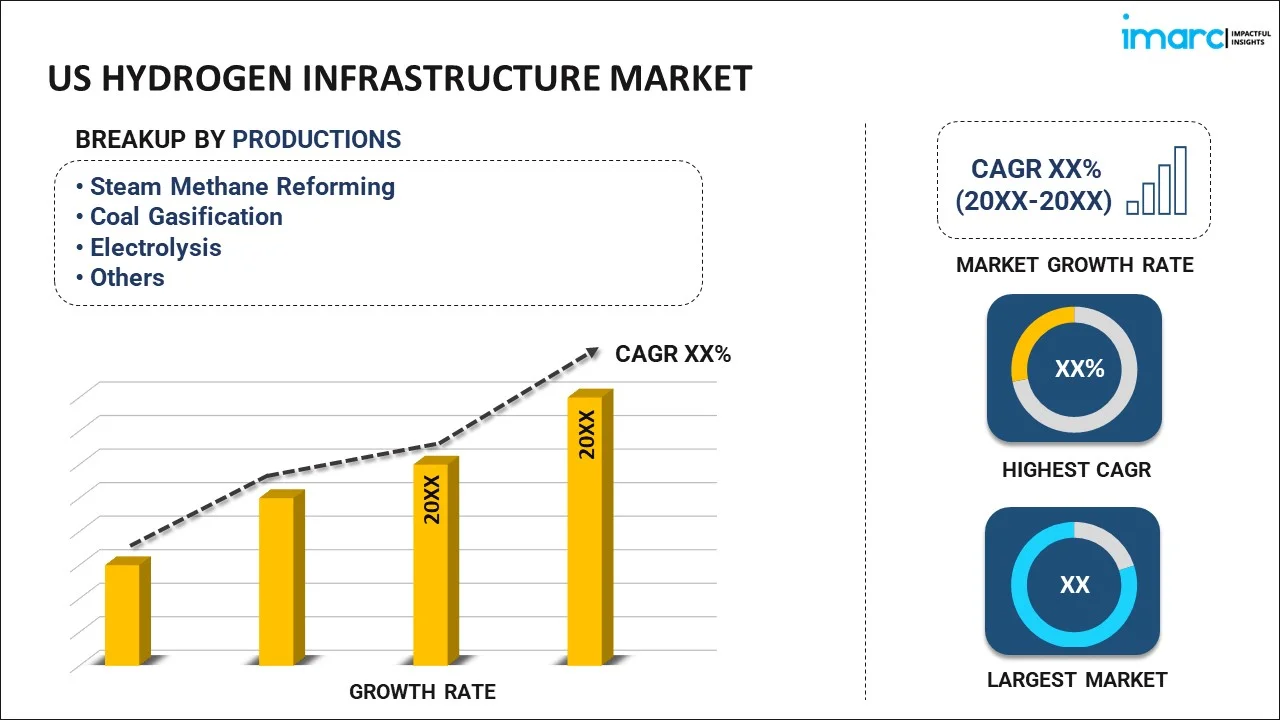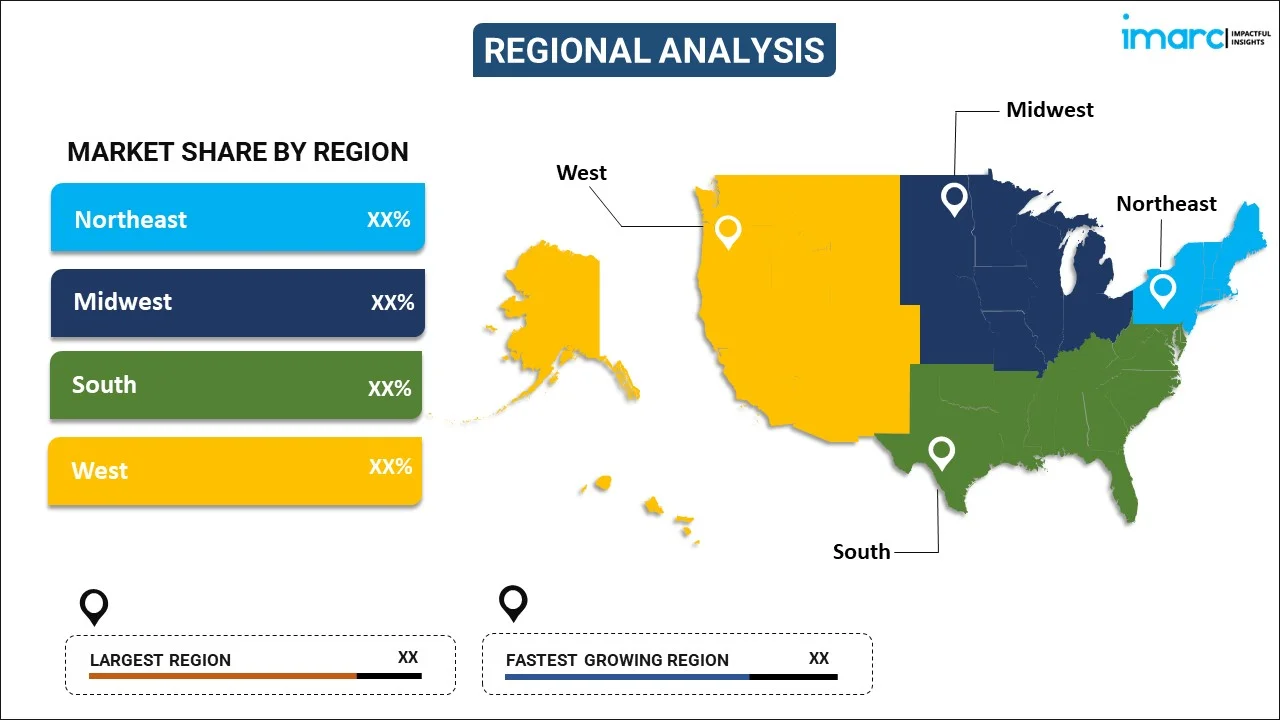
US Hydrogen Infrastructure Market Report by Production (Steam Methane Reforming, Coal Gasification, Electrolysis, and Others), Storage (Compression, Liquefaction, Material Based), Delivery (Transportation, Refinery, Power Generation, Hydrogen Refueling Stations), and Region 2025-2033
Market Overview:
The US hydrogen infrastructure market size reached USD 9.7 Billion in 2024. Looking forward, IMARC Group expects the market to reach USD 26.2 Billion by 2033, exhibiting a growth rate (CAGR) of 10.44% during 2025-2033. The enhanced focus on sustainability, significant technological advancements, growing compatibility with existing infrastructure, increasing energy storage solutions, proliferating public and private partnerships, and favorable government initiatives represent some of the key factors driving the market.
|
Report Attribute
|
Key Statistics
|
|---|---|
|
Base Year
|
2024 |
|
Forecast Years
|
2025-2033
|
|
Historical Years
|
2019-2024
|
| Market Size in 2024 | USD 9.7 Billion |
| Market Forecast in 2033 | USD 26.2 Billion |
| Market Growth Rate (2025-2033) | 10.44% |
Hydrogen infrastructure refers to the comprehensive system of technologies and facilities that produce, store, transport, and distribute hydrogen fuel. It serves as the backbone for the broader adoption of hydrogen as a clean energy source and encompasses various elements such as electrolyzers, pipelines, storage tanks, and refueling stations. Characterized by its scalability and adaptability, hydrogen infrastructure can range from small, localized systems for specific applications to expansive networks that serve large geographic regions. The inherent versatility of hydrogen as an energy carrier enables its use in a myriad of applications, from powering vehicles and industrial machinery to serving as a storage medium for renewable energy sources. Key features of hydrogen infrastructure include its modularity, which allows for incremental expansion as demand grows, and its compatibility with existing natural gas pipelines, offering a potential avenue for cost-effective development. The infrastructure also employs advanced safety measures, given that hydrogen is a flammable gas. Enhanced sensor technologies, specialized materials, and stringent operational protocols are often in place to ensure safe handling and storage. With the growing emphasis on sustainability and the reduction of carbon emissions, hydrogen infrastructure is rapidly evolving to meet the dual challenges of scalability and efficiency, leveraging advancements in electrolysis, compression, and storage technologies.
US Hydrogen Infrastructure Market Trends:
The enhanced focus on sustainability and clean energy represents one of the key factors driving the growth of the hydrogen infrastructure market in the United States. Moreover, the rising need for alternative fuel sources and energy storage solutions is catalyzing the demand for the hydrogen infrastructure market in the country. In addition to this, advancements in hydrogen production technologies, requiring sophisticated storage and transportation solutions, are facilitating the market growth of hydrogen infrastructure. The growing awareness around environmental conservation, coupled with an economy increasingly dependent on sustainable energy, is propelling market growth for hydrogen infrastructure. Along with this, the emergence of new manufacturing facilities and hydrogen refueling stations is stimulating the demand for hydrogen as a viable fuel alternative. The increasing focus on energy independence and security is leading to the rising demand for advanced and efficient hydrogen infrastructure, thus further fueling market growth. Moreover, ethical considerations around reducing carbon emissions and promoting sustainable practices are persuading stakeholders to invest in hydrogen technologies. Government initiatives aimed at climate change mitigation and energy diversification are also contributing significantly to market expansion. Additionally, a better understanding of the long-term economic benefits of sustainable energy and the growing preference for clean transportation options are driving the growth of the hydrogen infrastructure market. Other factors, such as supportive regulatory frameworks, the digitalization of energy management systems, and significant innovations in electrolysis techniques, are creating a positive outlook for the hydrogen infrastructure market in the United States.
US Hydrogen Infrastructure Market Segmentation:
IMARC Group provides an analysis of the key trends in each segment of the US hydrogen infrastructure market report, along with forecasts at the country level for 2025-2033. Our report has categorized the market based on production, storage, and delivery.
Production Insights:

- Steam Methane Reforming
- Coal Gasification
- Electrolysis
- Others
The report has provided a detailed breakup and analysis of the market based on the production. This includes steam methane reforming, coal gasification, electrolysis, and others.
Storage Insights:
- Compression
- Liquefaction
- Material Based
The report has provided a detailed breakup and analysis of the market based on the storage. This includes compression, liquefaction, and material based.
Delivery Insights:
- Transportation
- Refinery
- Power Generation
- Hydrogen Refueling Stations
The report has provided a detailed breakup and analysis of the market based on the delivery. This includes transportation, refinery, power generation, and hydrogen refueling stations.
Regional Insights:

- Northeast
- Midwest
- South
- West
The report has also provided a comprehensive analysis of all the major regional markets, which include Northeast, Midwest, South, and West.
Competitive Landscape:
The report has also provided a comprehensive analysis of the competitive landscape in the market. Competitive analysis such as market structure, key player positioning, top winning strategies, competitive dashboard, and company evaluation quadrant has been covered in the report. Also, detailed profiles of all major companies have been provided.
US Hydrogen Infrastructure Market Report Coverage:
| Report Features | Details |
|---|---|
| Base Year of the Analysis | 2024 |
| Historical Period | 2019-2024 |
| Forecast Period | 2025-2033 |
| Units | Billion USD |
| Scope of the Report | Exploration of Historical and Forecast Trends, Industry Catalysts and Challenges, Segment-Wise Historical and Predictive Market Assessment:
|
| Productions Covered | Steam Methane Reforming, Coal Gasification, Electrolysis, Others |
| Storages Covered | Compression, Liquefaction, Material Based |
| Deliveries Covered | Transportation, Refinery, Power Generation, Hydrogen Refueling Stations |
| Regions Covered | Northeast, Midwest, South, West |
| Customization Scope | 10% Free Customization |
| Post-Sale Analyst Support | 10-12 Weeks |
| Delivery Format | PDF and Excel through Email (We can also provide the editable version of the report in PPT/Word format on special request) |
Key Questions Answered in This Report:
- How has the US hydrogen infrastructure market performed so far and how will it perform in the coming years?
- What has been the impact of COVID-19 on the US hydrogen infrastructure market?
- What is the breakup of the US hydrogen infrastructure market on the basis of production?
- What is the breakup of the US hydrogen infrastructure market on the basis of storage?
- What is the breakup of the US hydrogen infrastructure market on the basis of delivery?
- What are the various stages in the value chain of the US hydrogen infrastructure market?
- What are the key driving factors and challenges in the US hydrogen infrastructure market?
- What is the structure of the US hydrogen infrastructure market and who are the key players?
- What is the degree of competition in the US hydrogen infrastructure market?
Key Benefits for Stakeholders:
- IMARC’s report offers a comprehensive quantitative analysis of various market segments, historical and current market trends, market forecasts, and dynamics of the US hydrogen infrastructure market from 2019-2033.
- The research study provides the latest information on the market drivers, challenges, and opportunities in the US hydrogen infrastructure market.
- Porter's five forces analysis assist stakeholders in assessing the impact of new entrants, competitive rivalry, supplier power, buyer power, and the threat of substitution. It helps stakeholders to analyz
ethe level of competition within the US hydrogen infrastructure industry and its attractiveness. - Competitive landscape allows stakeholders to understand their competitive environment and provides an insight into the current positions of key players in the market.
Need more help?
- Speak to our experienced analysts for insights on the current market scenarios.
- Include additional segments and countries to customize the report as per your requirement.
- Gain an unparalleled competitive advantage in your domain by understanding how to utilize the report and positively impacting your operations and revenue.
- For further assistance, please connect with our analysts.
 Inquire Before Buying
Inquire Before Buying
 Speak to an Analyst
Speak to an Analyst
 Request Brochure
Request Brochure
 Request Customization
Request Customization




.webp)




.webp)












